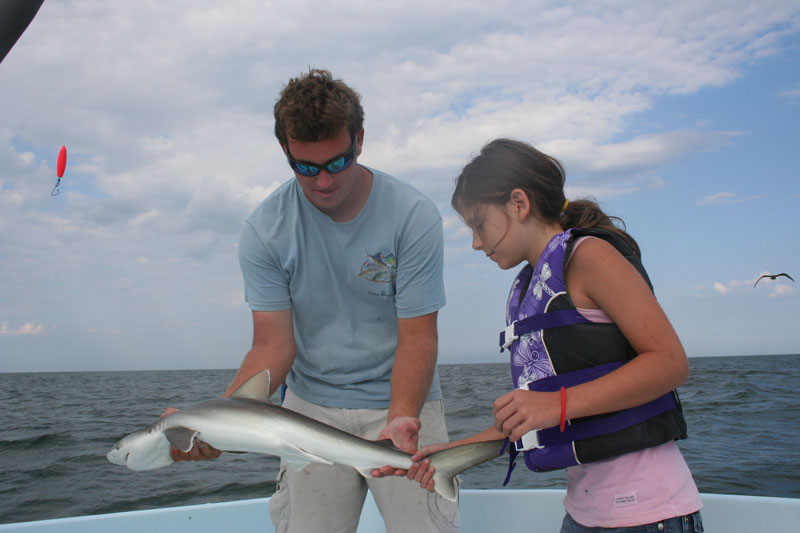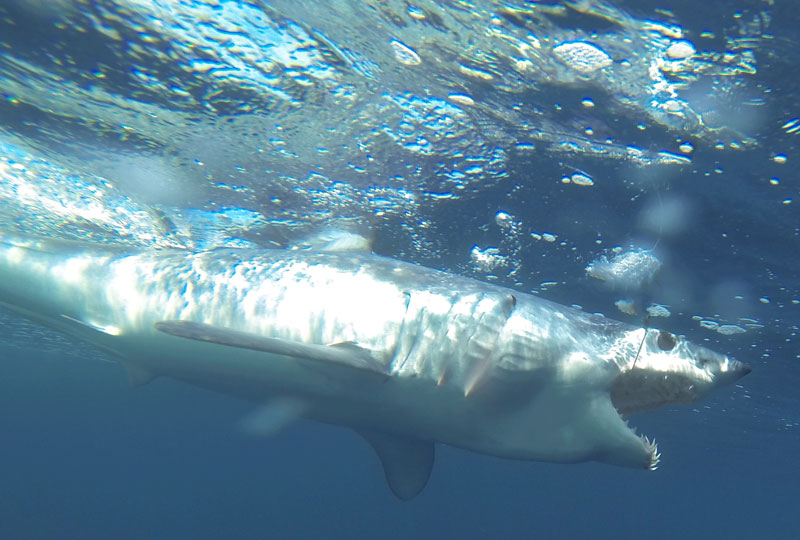Is there a kid alive who wouldn’t be thrilled to try fishing for sharks? We think not! Is there a more challenging, interesting species for a beginner angler to reel up to the surface of the water? Heck no! Plus, while the danger-factor of handling large sharks is very real, most of the sharks caught in the Bay, inshore, or on the beach are 10 pounds or less, which can be easily and safely dealt with as long as you use care — and tangling with even a small specimen is thrilling.

Mid-Atlantic Shark Species
There are a number of different types of sharks you might encounter in our region. Offshore there are blues, thresher, and even the famed mako sharks. We won’t get into detail with these species since they aren’t appropriate for beginners to target. But closer to home the species you’re more likely to encounter include:
Inshore Sharks
- Atlantic Sharpnose
- Dusky
- Sandbar
- Smooth sand sharks
- Spiny sand sharks
- Tiger
Sharks in the Surf
- Sand tigers
- Sandbar
- Smooth sand sharks
- Spiny sand sharks
Sharks in the Chesapeake Bay
- Bull
- Sandbar
- Smooth sand sharks
- Spiny sand sharks
Can You Eat Shark for Dinner?
It’s important to remember that sharks play a vital role in the food web, and as a general rule of thumb aren’t great to eat. Among the smaller inshore sharks you’re likely to encounter smooth sand shark and Atlantic sharpnose are considered good eating, but all other species should be released with care.
Smooth sand sharks (also called dogfish) are one of the most common catches made while surf fishing, as they’re quite prolific and will eat just about anything. Most are just a foot or two long. But be careful not to mix them up with spiny sand sharks (which have a prominent spike on their dorsal fin) if you plan to take one home to eat, or you’ll be sorely disappointed when you take the first bite.
Atlantic sharpnose, which commonly range from two to three feet long, are a prime target for many nearshore boat anglers as they’re feisty, fun to catch, good to eat, and quite common in near-shore waters from midsummer into the fall. You’ll find them cruising along in sloughs and depressions anywhere from a few miles off the beach to 20 miles out. The species is easily recognized by the distinctive white splotchy dots across their bronze back and sides, and they’re an ideal target for recreational anglers using relatively light gear.
How to Fish for Sharks
Just what tactics and techniques you'll use will differ depending on how and where you do your fishing. So, let's break this section down:
Targeting Sharks Offshore

This will be a very short section, because we’re not about to suggest that any beginners target the large, dangerous species of sharks found offshore. If you want to do so you should take out a charter boat that specializes in shark fishing and see how the pros do it. There are also several articles on shark fishing at FishTalkMag.com for more advanced anglers.
Shark Fishing in the Surf
As mentioned earlier, for sand sharks you can toss out just about any bait and wait for a bite. That said, cut fish is the best bet and any time you’re targeting sharks, even these small ones, it’s best to use a wire leader or at least a long-shank hook.
To target larger sharks, you’ll want to up-size your baits, hooks, and gear. If local rules allow (and in some areas they do not) you can seriously boost your chances of hooking a larger shark by deploying your baits far off the beach via a kayak. In this case, you’ll want a three- to four-foot strand of #10 wire connecting the hook to the mainline, with a 9/0 to 12/0 circle hook on the business end. Use a large slice of mackerel or bluefish for bait, and be sure it’s hooked such that the point of the circle hook is thoroughly exposed. For tips and pointers on the technique see Shark Fishing with a Kayak.
Note: with many of the larger species, such as sand tigers, it’s illegal to remove the shark from the water prior to releasing it. Dragging a shark up on the beach can be fatal, as it subjects the creature to stresses and internal injury its body can’t handle. You should remove the hook while the fish is still in the wash, and obviously, care must be taken to keep your fingers clear of the teeth. If you want to get photos, have someone else assigned to the task beforehand. We’d recommend going with a surf fishing guide (there aren’t many but there are a few like Shark Whisperers, who you can find on Facebook) or an experienced angler before thinking about catching large sharks in the surf on your own.
Shark Fishing in the Chesapeake Bay
To target sharks inshore and in the lower Bay, you’ll want to anchor your boat along the edge of a shoal or next to structure on bottom and then set out your lines on bottom with cut fish baits. Mackerel, bluefish, and other oily fish work best. Use 8/0 to 10/0 circle hooks rigged with three- to five-foot wire leaders, attached to your main line with a swivel.
You can attract fish to the area by hanging a weighted chum bucket full of ground fish over the side of the boat, suspended just above the bottom. A modest but steady flow of finely ground-up fish streaming from the chum bucket is best.
When a shark first bites don’t do a thing: let the circle hook do its work. When the rod begins to bend over, it’s time to pick up the rod, reel slowly to apply maximum tension, then fight it up.
Shark fishing isn’t complex, but it can be incredibly exciting. And there’s not a kid on the face of the planet who won’t be thrilled by reeling up a shark. So take the proper precautions, rig up right, and get one of these apex predators on the line.
Shark Fishing Safety
It goes without saying that sharks are dangerous creatures. When possible, remove the hook using a pair of long-nose pliers with the fish still in the water. Smaller ones can be handled by grabbing around the base of the tail with one hand, and around the back of the head behind the jaws and just in front of the pectoral fins with the other. Don’t try to hold them up vertically by the tail, because they can bend around and snap at your wrist or hand. Removing the hook from medium-sized sharks — and certainly larger sharks — is a two-person operation. If there’s any doubt as to whether you can safely handle a shark simply clip off the line as close to the hook as possible, leave it in place, and let the shark swim off.
Whenever you’re shark fishing from the beach, there’s the potential for “user conflict.” While we here at FishTalk are always supportive of anglers’ fishing rights wherever and however casting a line is legal, we should note that it’s understandable that bathers may become uncomfortable if a shark angler sets up shop a few yards away from their beach umbrellas. Moving away from bather access points and giving other people a wide berth is certainly the right move.